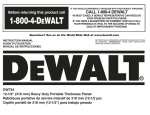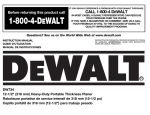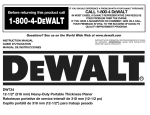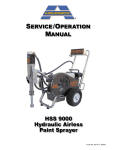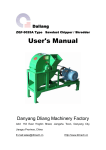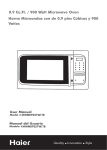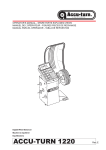Download DeWalt DW734-XE Instruction manual
Transcript
DE WALT Industrial Tool Pty. Ltd..,20 Fletecher Road Mooroolbark,Victoria, Australia 3138 (MAY03) Form No. 620422-00 DW734 Copyright © 2003 The following are trademarks for one or more DEWALT power tools: the yellow and black color scheme; the “D” shaped air intake grill; the array of pyramids on the handgrip; the kit box configuration; and the array of lozenge-shaped humps on the surface of the tool. INSTRUCTION MANUAL DW734-XE 318 mm (12-1/2”) Heavy Duty Portable Thickness Planer SAVE THESE INSTRUCTIONS IMPORTANT SAFETY INSTRUCTIONS FOR ALL TOOLS WARNING: For your own safety, read the instruction manual before operating the planer. Failure to heed these warnings may result in personal injury and serious damage to the planer. When servicing this tool, use only identical replacement parts. Have damaged cords replaced by an authorized service center. DOUBLE INSULATION Double insulated tools are constructed throughout with two separate layers of electrical insulation or one double thickness of insulation between you and the tool’s electrical system. Tools built with this insulation system are not intended to be grounded. As a result, your tool is equipped with a two prong plug which permits you to use extension cords without concern for maintaining a ground connection. NOTE: Double insulation does not take the place of normal safety precautions when operating this tool. The insulation system is for added protection against injury resulting from a possible electrical insulation failure within the tool. GENERAL SAFETY INSTRUCTIONS • KEEP GUARDS IN PLACE and in working order. • REMOVE ADJUSTING KEYS AND WRENCHES. Form habit of checking to see that keys and adjusting wrenches are removed from tool before turning it on. • KEEP WORK AREA CLEAN. Cluttered areas and benches invite injuries. • DON’T USE IN DANGEROUS ENVIRONMENT. Don’t use power tools in damp or wet locations, or expose them to rain. Keep work area well lighted. Always operate tool in a well-ventilated area free of combustible materials, gasoline or solvent vapors. If sparks come in contact with flammable vapors, they may ignite, causing fire or explosion. • KEEP CHILDREN AWAY. All visitors should be kept safe distance from work area. • MAKE WORKSHOP KID PROOF with padlocks, master switches, or by removing starter keys. • DON’T FORCE TOOL. It will do the job better and safer at the rate for which it was designed. • USE RIGHT TOOL. Don’t force tool or attachment to do a job for which it was not designed. • USE PROPER EXTENSION CORD. Make sure your extension cord is in good condition. When using and extension cord, be sure to use one heavy enough to carry the current your product will draw. An undersized cord will cause a drop in line voltage resulting in loss of power and overheating. The following table shows the correct size to use depending on cord length and nameplate ampere rating. If in doubt, use the next heavier gage. The smaller the gage number, the heavier the cord. When operating a power tool outside, use an outdoor extension cord marked “W-A” or “W.” These cords are rated for outdoor use and reduce the risk of electric shock. • • • • • • • • • • • • MINIMUM GAGE FOR CORD SETS Volts Total Length of Cord in Feet 240V 0-50 51-100 101-200 201-300 Ampere Rating More Not more AWG Than Than 12 - 16 14 12 Not Recommended WEAR PROPER APPAREL. Do not wear loose clothing, gloves, neckties, rings, bracelets, or other jewelry which may get caught in moving parts. Nonslip footwear is recommended. Wear protective hair covering to contain long hair. Air vents often cover moving parts and should also be avoided. ALWAYS USE SAFETY GLASSES. Also use face or dust mask it cutting operation is dusty. Everyday eyeglasses only have impact resistant lenses, they are not safety glasses. ACTUATING TOOL MAY RESULT IN FLYING DEBRIS, COLLATION MATERIAL, OR DUST WHICH COULD HARM OPERATOR’S EYES. The operator and all those persons in the general area should wear safety glasses with permanently attached side shields. It is the employer’s responsibility to enforce the use of eye protection equipment by the tool operator and other people in the work area. DON’T OVERREACH. Keep proper footing and balance at all times. MAINTAIN TOOLS WITH CARE. Keep tools sharp and clean for best and safest performance. Follow instructions for lubricating and changing accessories. DISCONNECT TOOLS FROM POWER SUPPLY before servicing; when changing accessories, such as blades, bits, cutters, and the like. REDUCE THE RISK OF UNINTENTIONAL STARTING. Make sure switch is in OFF position before plugging in. USE RECOMMENDED ACCESSORIES. Consult the instruction manual for recommended accessories. The use of improper accessories may cause risk of injury to persons. NEVER STAND ON TOOL. Serious injury could occur if the tool is tipped or if the cutting tool is unintentionally contacted. CHECK DAMAGED PARTS. Before further use of the tool, a guard or other part that is damaged should be carefully checked to determine that it will operate properly and perform its intended function–check for alignment of moving parts, binding of moving parts, breakage of parts, mounting, and any other conditions that may affect its operation. A guard or other part that is damaged should be properly repaired or replaced. DIRECTION OF FEED. Feed work into planer according to direction of feed arrows on top of the unit. NEVER LEAVE TOOL RUNNING UN ATTENDED. TURN POWER OFF. Don’t leave tool until it comes to a complete stop. ADDITIONAL SPECIFIC SAFETY RULES FOR PLANERS • To reduce the risk of injury, user must read and understand instruction manual before operating planer. • Always wear eye protection and dust mask if necessary. • Keep hands 6” away from cutter head carriage when feeding work piece. 1 • Never clear clogs, make cutter knife replacement or any other repairs/adjustments with unit plugged in. • Make certain that the switch is in the OFF position before connecting plug to a power source. • To prevent unexpected “turn on” of the tool after power is disrupted, turn the switch OFF before restoring power. • Be sure that the cutter knives are mounted as described in the instruction manual and check that all bolts are firmly tightened before connecting unit to power source. • To avoid injury, never rotate the cutter block directly with your hands. • Keep guards in place and in good working order. • Stay alert - never operate the unit when tired or under the influence of drugs, alcohol, or medication. • Do not use in dangerous environments. Do not use near flammable substances, in damp or wet locations, or expose to rain. • Never plane material which is shorter than 12 inches. • Exhaust chute: remove shavings with brush or vacuum after power has been shut off and cutter head has stopped rotating. • ALWAYS LOCATE PLANER WITH PROPER CLEARANCE ON THE OUTFEED SIDE of the unit to prevent pinching or binding of the workpiece against any obstacles. • Clean out your tool often, especially after heavy use. Dust and grit containing metal particles often accumulate on interior surfaces and could create a risk of serious injury, electric shock or electrocution. ALWAYS WEAR SAFETY GLASSES. WARNING: For your own safety, it is recommended that two people carry this machine or serious injury could result. CAUTION: Wear appropriate personal hearing protection during use. Under some conditions and duration of use, noise from this product may contribute to hearing loss. WARNING: Some dust created by power sanding, sawing, grinding, drilling, and other construction activities contains chemicals known to cause cancer, birth defects or other reproductive harm. Some examples of these chemicals are: • lead from lead-based paints. • crystalline silica from bricks and cement and other masonry products. • arsenic and chromium from chemically-treated lumber (CCA). Your risk from these exposures varies, depending on how often you do this type of work. To reduce your exposure to these chemicals: work in a well ventilated area, and work with approved safety equipment, such as those dust masks that are specially designed to filter out microscopic particles. • Avoid prolonged contact with dust from power sanding, sawing, grinding, drilling, and other construction activities. Wear protective clothing and wash exposed areas with soap and water. Allowing dust to get into your mouth, eyes, or lay on the skin may promote absorption of harmful chemicals. CAUTION: A dust mask or respirator should be worn by all persons entering the work area. The filter should be replaced daily or whenever the wearer has difficulty breathing. See your local hardware store for the proper approved dust mask. • The label on your tool may include the following symbols. The symbols and their definitions are as follows: V ...........volts A......... amperes Hz..........hertz W........ watts min........minutes ~ ....... alternating current no ....... no load speed ..... direct current ......... Class II Construction ....... earthing terminal ......... safety alert symbol .../min . revolutions per ............. minute SPECIFICATIONS Input ....................................... 240V AC, 15 Amp No-load speed ........................ 10,000 RPM Feed speed ............................. 7.9M per minute Planing height ......................... Max 152.4mm(6”), Min 3.18mm (1/8”) Planing width .......................... Max 318mm (12-1/2”) Planing depth.......................... Max 3.18mm(1/8”) (for boards 152.4mm6” wide or less) ELECTRICAL CONNECTION Be sure your power supply agrees with the nameplate marking. Volts, 50 Hz or “AC only” means your planer must be operated only with alternating current and never with direct current. Voltage decrease of more than 10% will cause loss of power and overheating. All DeWalt tools are factory tested, if this tool does not operate, check the power supply. UNPACKING YOUR PLANER (FIG. 1) Check the contents of your planer carton to make sure you have received all parts. In addition to this instruction manual, the carton should contain: • 1 Planer • 1 Depth Adjustment Crank Handle • 1 Allen Screw for Crank Handle • 1 Dust Hood • 1 Crescent Wrench • 1 T-Wrench These tools are located in the tray (A) on the back side of your planer, as shown in Figure 1. TRANSPORTING THE PLANER WARNING: For your own safety, it is recommended that two people carry this machine or serious injury could result. When moving your planer, hold it by the side carrying handles (B) or by the hand indentation (C) at the base of the planer. (Fig. 2). When transporting or storing the planer, use the cord wrap (D) located in the back of the tool (Fig. 3) to keep the cord in place. BENCH MOUNTING To facilitate bench mounting, two different sized holes (E) are provided on the four corners of your planer as shown in Figure 4. If mounting the planer with bolts, use the larger holes. If mounting the planer with nails or screws, use the smaller holes. It is not necessary to use both sets of holes. Always mount your planer firmly to a secure surface to prevent move- ment. To enhance the tool’s portability, it can be mounted to a piece of 1/2” (12.7mm) or thicker plywood which can then be clamped to your work support or moved to other work areas and reclamped. NOTE: If you elect to mount your planer to a piece of plywood, make sure that the mounting screws don’t protrude from the bottom of the wood. The plywood must sit flush on the work support. CAUTION: The mounting surface should not be warped or otherwise uneven. FIG. 1 FIG. 2 A B ASSEMBLY DEPTH ADJUSTMENT CRANK HANDLE TO ATTACH THE DEPTH ADJUSTMENT CRANK HANDLE 1. Insert the crank handle (F) over the shaft (Fig. 5). 2. Secure the crank handle in place with the Allen screw and Twrench provided. C FIG. 3 OPERATION ON/OFF SWITCH To turn the planer on, lift up the switch (G). The planer locks on automatically. To turn the tool off, press the switch down. A hole (H) is provided on the underside of the switch to insert a padlock to lock off the planer as shown in Figure 6. D TABLE EXTENSIONS Before using your planer, fold down the table extensions in the front and back of the tool (Fig. 7). After extended use, the table extensions may be slightly out of level. See Leveling the Table Extensions in the Maintenance section of this manual. NOTE: The outside edges of the extension tables are level with the base while the inside edges (closest to the cutter head) are below the edge of the base. This is set at the factory to reduce unnecessary friction between the material and the table while providing adequate support at the two points (those farthest from the cutter head) on the tables that are integral to snipe prevention. FIG. 4 E CARRIAGE HEAD LOCK Your planer is equipped with a carriage head lock lever (I) located on top of the motor (Fig. 8). This device secures the carriage that holds the cutter head to the four posts of your planer. By locking the carriage to the four posts, the movement that causes snipe is drastically minimized. DEPTH ADJUSTMENT The depth adjustment scale (J) indicates the finished thickness of your workpiece (Fig. 9). One rotation of the depth adjustment crank is equal to 1.6mm (1/16”); half a rotation is equal to .80mm (1/32”), etc. TO SET THE FINISHED THICKNESS 1. Raise head lock lever to unlock the cutter head (Fig. 8). This allows the cutter head to be adjusted. 2. Adjust the thickness. Turn the depth adjustment handle clockwise to lower the cutter head. Turn the handle counter-clockwise to raise the cutter head. One full rotation of the handle moves the cutter head 1.6mm (1/16”). 3. Depress the head lock lever to re-lock before planing. NOTE: Do not attempt to adjust the carriage height while the carriage lock is engaged. You may damage the machine. 2 FIG. 6 FIG. 5 F G H FIG. 7 FINE ADJUSTMENTS The depth adjustment handle allows for fine adjustments, from .40mm (1/64”) to 1.6mm (1/16”.) Fine adjustments are ideal for “shaving” small amounts from your material. For example, if your planed workpiece measures 77.79mm (3-1/16”) thick, but should be 76.2mm (3”) thick, adjust your planer to remove the excess 1.6mm (1/16”) as follows: 1. Plane and measure your workpiece. In this example, the finished thickness is 77.79mm (3-1/16”). 2. Turn the circular label on the depth adjustment handle until the “0” mark aligns with the arrow on the top of the tool. Do not make any other adjustments to the planer. 3. Turn the depth adjustment handle clockwise until the 1.6mm (1/16”) mark aligns with the arrow. 4. Plane your workpiece. The final thickness should be 76.2mm (3”). FIG. 8 I TO ADJUST THE 3/4” STOP FOR OTHER THICKNESSES 1. Unlock the head lock lever (Fig. 8) and turn the adjustment handle counterclockwise to raise the cutter head. 2. From the back of the tool, locate the turret adjustment bolt (N) shown in Figure 11. This bolt is set for a 19.1mm (3/4”) depth of cut at the factory. Use the wrench provided to loosen the jam nut. Adjust the bolt up or down to reach the desired planing depth. 3. Turn the depth adjustment crank, lowering the carriage by the desired increments, until it contacts the turret stop. R FIG. 9 MATERIAL REMOVAL GAUGE Your planer is equipped with a material removal gauge. It is used to indicate the amount of wood that will be removed in one pass with the carriage set at its current height. TO USE THE MATERIAL REMOVAL GAUGE WARNING: DO NOT SWITCH THE UNIT ON WITH THE MATERIAL POSITIONED UNDER THE CARRIAGE. SERIOUS INJURY COULD RESULT. 1. Slide approximately 3” of your material under the arrow (K) located in the middle of the carriage (Fig. 10). 2. The wood must lay flat against the base of the planer. If the material is inserted at an angle, the reading may be inaccurate. 3. Unlock and crank the carriage down on the material until the material removal bar engages the wood. The red indicator (L) moves up the scale indicating the amount of material to be removed with the carriage at that height. 4. Adjust the carriage height until the desired depth of cut appears on the gauge. 5. Pull the material out from under the carriage. 6. Lock the carriage lock lever. 7. Turn the unit on and feed your material into the cutter head. NOTE: Do not exceed the recommended depth of cut for various widths of material recommended on the material removal gauge (Table A). TURRET STOP Your planer is equipped with a turret stop (M), shown in Figure 11, for repetitive planing of pre-set depths. Stops are set at 0”, 6.35mm (1/4”),12.7mm (1/2”) and 19.1mm (3/4”. Use the 0” setting when planing between 3.18mm (1/8”) and 6.35mm(1/4”). TO SET A PLANING DEPTH 1. Be sure the carriage is set above 31.75mm (1-1/4”) before trying to set the turret stop. 2. Turn the turret stop until the desired measurement shows (Fig. 11). 3. Unlock the head lock lever (Fig. 8). Turn the depth adjustment crank, lowering the carriage by the desired increments, until it contacts the turret stop. NOTE: DO NOT USE FORCE TO CRANK THE CARRIAGE BELOW THE LEVEL THAT THE TURRET STOP INDICATES. PERMANENT DAMAGE TO THE HEIGHT ADJUSTMENT SYSTEM ON YOUR PLANER WILL RESULT. NOTE: The 3/4” turret stop can be adjusted for other planing thicknesses. Adjusting the 3/4” turret stop does not affect the other turret stop settings. PLANING BASICS PROPER PLANING TECHNIQUE R J FIG. 10 K L FIG. 11 N 34 M 3 WARNING: DO NOT TURN THE UNIT ON WITH THE MATERIAL ALREADY INSERTED UNDER THE CARRIAGE. WAIT UNTIL THE ROLLERS AND CUTTER HEAD ARE UP TO FULL SPEED BEFORE FEEDING YOUR MATERIAL INTO THE MACHINE. TO PLANE YOUR MATERIAL Your planer works best on Timber with at TABLE A least one flat surface. Support the workpiece adequately at all times. The maximum depth of cut your planer can take in one pass is 3.18mm (1/8”) (on material less than 152.4mm (6”) wide). Never attempt to modify your planer to take a deeper cut. Follow the depth/width of cut guidelines shown in Table A for best results. 1. Lower the carriage to the desired height for your first pass. 2. Turn the unit on and feed the material into the feed rollers. 3. Examine the finished cut and adjust the carriage to the appropriate height for your next pass. See the Troubleshooting Guide at the end of this section for more information. WARNING: Do not place your body between the workpiece and a stationary structure while the matertial is feeding out. Personal injury and/or damage to the work piece may occur. WARNING: Plane only wood that is free from foreign objects, with no loose knots and as few tight knots as possible. Do not plane wood that is severely warped, twisted, knotted or bowed. NOTE: For best results, plane both sides of the workpiece to reach a desired thickness. For example, if you need to remove 3.18mm (1/8”) from your workpiece, remove 1.6mm (1/16”) from each side. This not only allows the workpiece to dry with a even moisture content, it also produces finer cuts. NOTE: Always plane in the direction of the grain. Planing material less than 19.1mm (3/4”) wide is not recommended. If you must plane narrow material, group the pieces together and plane them as one wide workpiece whenever possible. MINIMUM/MAXIMUM WIDTH/HEIGHT/DEPTH NOTE: There is a certain area on the carriage of your planer that will allow the 3.18mm (1/8”) depth of cut on material less than 152.4mm (6”) wide. See Figure 12 for an approximate location of this area. Your material must move under this section of the carriage or planer will not take a 3.18mm (1/8”) depth of cut. If the material is wider than 6”, it will not fit through this area with an 3.18m (1/8”) depth cut. FIG. 12 CHANGING THE PLANER KNIVES R WARNING: DISCONNECT THE PLANER FROM THE POWER SOURCE BEFORE ATTEMPTING TO ACCESS OR CHANGE THE KNIVES. Your planer is equipped with a three-knife cutter head. SNIPE Snipe is a depression made when an unsupported end of your material bends downward, causing the opposite end to lift up into the cutter head. If you are planing material that is especially long, the use of additional material support is recommended. TO AVOID SNIPE Feed the workpiece into the planer so it is level and remains flat against the base at all times. Keep long workpieces level throughout planing operation by receiving or “catching” them from the rear of the planer. WARNING: Do not place your body between the workpiece and a stationary structure while the matertial is feeding out. Personal injury and/or damage to the work piece may occur. TWISTED, CUPPED AND BOWED WOOD If both sides of your material are very rough or if the material is cupped, bowed or twisted, the planer may not produce the desired result. Ideally, you should have at least one level face/surface on your material before you plane. Your thickness planer will work best with material that has been run through a jointer to produce one flat surface. If you do not have at least one flat surface or a jointer, see the the following recommendations. FIG. 13 FIG. 14 FIG. 15 TOP FLAT TO PLANE TWISTED WOOD (FIG. 13) WARNING: TWISTED WOOD MAY JAM YOUR THICKNESS PLANER. IF A JAM OCCURS, TURN THE POWER OFF, DISCONNECT THE POWER SUPPLY AND RAISE THE CARRIAGE TO RELEASE THE MATERIAL FROM THE CUTTER HEAD. To plane only slightly twisted material: Plane both sides alternating from one to the other until the desired thickness is reached. TO PLANE CUPPED WOOD (FIG. 14) To obtain the best possible results with cupped wood: Rip the material down the middle and plane it as two separate pieces. NOTE: Ripping the material reduces the severity of the cup and allows the machine to deliver better results. More material will be removed on cupped wood to achieve the desired thickness than on a normal board. If ripping the material is not an option: Plane one side of the material until flat, then plane the opposite side until flat (Fig. 15). NOTE: Do not flip the board back and forth between each pass as recommended by the general planing directions. BOTTOM FLAT FIG. 16 BOWED WOOD WILL BE FLATTENED BY FEED ROLLERS AND CUTTER HEAD… …BUT BOW WILL RETURN AFTER WOOD IS PLANED TO PLANE BOWED WOOD (FIG. 16) The feed rollers and cutter head in your planer will push the bow out of the material as it feeds. When the material exits the planer, the pressure of the rollers and cutter head will release allowing the wood to spring back into a bowed formation. 4 TO CHANGE PLANER KNIVES 1. Use the T-wrench to remove the tool tray. The cutter head should now be exposed. If the eight bolts in the knife clamp ARE NOT visible, use a piece of scrap wood to carefully rotate the cutter head until the bolts are accessible and the cutter head locking lever engages as shown in Figure 21 (O). This will prevent further rotation of the cutter head as you change each knife (Fig. 17). If the bolts ARE visible, be sure that the cutter head locking lever is engaged so the cutter head does not rotate while you are changing the knives. To do this, use a piece of scrap wood to attempt to rotate the cutter head. The locking lever will click into place if it is not already engaged. WARNING: KEEP YOUR FINGERS AWAY FROM THE CUTTER HEAD AT ALL TIMES. USE THE TOOL PROVIDED TO HANDLE THE KNIVES. 2. Remove bolts from knife clamp. 3. Use the magnets on the top of the T-wrench to attract the knife clamp and lift the knife off the cutter head (Fig. 18). One of the knives should now be exposed. 4. Use the magnet on the top of the T-wrench to attract and handle the knife. AVOID TOUCHING THE KNIFE WITH YOUR FINGERS. The knives on your planer are sharpened on both edges. If only one edge of the knife is worn: 1. Turn the knife around so that the sharp, unused edge hangs over the edge of the cutter head where it will cut the material. Be sure to set the oblong holes in the knife over the pins machined on the cutter head (Fig. 19). 2. To reset the knife clamp, align the beveled edge of the knife clamp with the cutting edge of the knife (Fig. 20). If these are not aligned correctly, the clamp will not secure the knife properly. 3. Place the screws through the holes in the knife clamp and knife into the cutter head. 4. Tighten the screws sufficiently. To access and replace the other two knives: 1. Depress the cutter head lock lever (O) as shown in Figure 21. 2. Use the piece of scrap wood to carefully turn the cutter head until it locks into place revealing another knife clamp and dull knife. 3. Repeat the procedure indicated above. If the knives are dull on both edges: 1. Follow the same knife change procedure indicated above. HOWEVER, discard the dull knives and install new ones onto the cutter head. 2. Repeat the procedure for the remaining knives. After installing or reversing the knives: 1. Replace the tool tray onto the unit. 2. Tighten the screws onto the tray. NOTE: THE PLANER WILL NOT OPERATE IF THE TOOL TRAY IS NOT INSTALLED CORRECTLY. MAINTENANCE INSTALLING A NEW BELT NOTE: No tools are necessary to install a belt. The use of a screwdriver or other tool to pry or stretch a belt may cause damage to the pulleys and ultimately destroy the new belt. WARNING: TURN OFF THE PLANER AND DISCONNECT IT FROM THE POWER SOURCE. 1. Remove the crank handle. 2. Remove the two Allen screws from the top, right side of the planer. 3. Remove the two, small Phillips head screws securing the side panels to the top of the planer. 4. Lift the side panel up out of the slot in the base and remove the panel fro the machine. Notice the grooves inside the belt. 5. Start the belt on the top pulley (P) with 3 grooves on the pulley, as shown in Figure 22. 6. Guide the belt between the lower pulley and the height adjustment screw (Q), as shown in Figure 23. 7. With three grooves engaged on the large pulley, rotate the pulley clockwise. Keep pressure on the edge of the belt to keep the grooves engaged on the small pulley. 8. Continue pressure on the side of the belt and rotate the large pulley while hopping the belt further onto the pulleys, as shown in Figure 24. 9. All of the belt grooves should be engaged in the final position and the pulleys should rotate smoothly. 10. Reinstall the side cover and the screws. Do not overtighten the self-tapping screws. CALIBRATING THE DEPTH ADJUSTMENT SCALE The depth adjustment scale on your planer is set at the factory. However, with extended use, the depth adjustment scale could show an incorrect measurement. TO CHECK THE DEPTH ADJUSTMENT SCALE 1. Plane a piece of wood, noting the measurement on the depth adjustment scale. 2. Measure the finished thickness of the workpiece. 3. If the thickness of the workpiece does not match the reading on the depth adjustment scale, loosen the two Phillips head screws (R) shown in Figure 25. 4. Adjust the pointer up or down until its reading matches the finished thickness of the workpiece. Securely re-tighten the screws. LEVELING THE TABLE EXTENSIONS After extended use, the table extensions might become slightly out of level. To ensure that the tables are level, place a straight edge on the table extension. The straight edge should contact the edge of the table extension and the main table (Fig. 7). When leveling, press the edge of the table extensions down to remove any play. For best results, use a level long enough to contact the edges of both table extensions. If the table extensions are not level, loosen the jam nuts (T) and adjust the table extension support bolts (S) up or down (Fig. 26). NOTE: The outside edges of the extension tables are level with the base while the inside edges (closest to the cutter head) are below the edge of the base. This is set at the factory to reduce unnecessary friction between the material and the table while providing adequate support at the two points (those farthest from the cutter head) on the tables that are integral to snipe prevention. TABLE Keep the table clean and free from oil, grease and pitch. Treat the table with paste wax to help maintain its smooth finish. FIG. 17 CIRCUIT BREAKER RESET BUTTON Your planer is equipped with an 18 amp circuit breaker. If your planer becomes overloaded and stops operating, turn off the planer, let the unit sit for 2 minutes and press the reset button (U) (Fig 27) before you resume working. WARNING: To prevent the planer from starting unexpectedly if power is interrupted by a circuit breaker trip, make sure the switch is in the OFF position before restoring power. NOTE: Circuit breaker overload is often the result of dull knives. Change your knives on a regular basis to avoid tripping your breaker. Check your knives before re-setting the circuit breaker and continuing to plane. See the Troubleshooting Guide at the end of this section for more information. FIG. 18 BRUSHES Inspect carbon brushes regularly. Keep brushes clean and sliding freely in their guides. Always replace a used brush in the same orientation in the holder as it was prior to its removal. Carbon brushes have varying symbols stamped into their sides, and if the brushes are worn down to the line closest to the spring, they must be replaced. Use only identical DEWALT brushes. New brush assemblies are available at DEWALT service centers. After replacing brush assemblies, the tool should be allowed to “run in” (run at no load) for 10 minutes to seat new brushes before using. TO REMOVE BRUSH ASSEMBLY WARNING: DISCONNECT TOOL FROM THE POWER SOURCE BEFORE ATTEMPTING TO REMOVE BRUSH ASSEMBLY. 1. Remove the brush inspection cap (V) (Fig 28). 2. Withdraw the brush assembly. FIG. 19 FIG. 20 CLEANING AND LUBRICATION CAUTION: Never let any liquid get inside the tool; never immerse any part of the tool into a liquid. Electric shock may result. CAUTION: Never use solvents or other harsh chemicals for cleaning the non-metallic parts of the tool. It is recommended that, once a year, you take or send the tool to a DEWALT certified service center for a thorough cleaning, inspection and lubrication of the gear case. O FIG. 21 5 FIG. 27 FIG. 22 U 30 Day No Risk Satisfaction Guarantee FIG. 28 If you are dissatisfied with any DEWALT power tool , for any reason, simply return it to the point of purchase with your sales receipt within 30 days for a replacement unit or full refund. INFORMATION HOTLINE V R P FIG. 24 FIG. 23 Q ACCESSORIES Recommended accessories for use with your tool are available at extra cost from your distributor or local service centre. Four accessories are available for the DW734 Thickness planer. • DW7331 Dust Hood for DW734 (Also fits the DW733) • DW7342 318 mm (12-1/2”) Reversable Planer Knives CAUTION: The use of any other accessory not recommended for use with this tool could be hazardous. DEWALT AFTER SALES SERVICE All power tools are thoroughly tested before leaving the factory. However, if the power tool needs repair, please contact your dealer or take it to your nearest DEWALT Service Centre. There is a Service Centre in every capital city. For service, repair or parts call 1800 654 155. ACCESSORIES Recommended accessories for use with your tool are available at extra cost from your local service centre. Call 1800 654 155 (Aust) or 09 526 2556 (NZ). CAUTION: The use of any non-recommended accessory may be hazardous. FIG. 25 GUARANTEE R FIG. 26 R Full One Year Warranty DEWALT heavy duty industrial tools are warranted for one year from date of purchase. We will repair, without charge, any defects due to faulty materials or workmanship. Please return the complete unit, transportation prepaid, to any DEWALT Service Centre, or any authorised service station. This warranty does not apply to: • Accessories • Damage caused where repairs have been made or attempted by others • Damage due to misuse, neglect, wear and tear, alteration or modification. Free One Year Service Contract S In addition to a full one year warranty, every DEWALT tool is backed with a Free One Year Service Contract. We will provide free labour on all repairs and preventative maintenance during the first year after purchase. Proof of purchase date is required.Contact your Service Centre on 1800 654 155.(Aust) or 09 526 2556 (NZ). T 6 When you need further information on a DEWALT product please phone: AUSTRALIA: 1800 816 900 NEW ZEALAND: 09 579 7600 Unwanted Tools and the Environment Take your old tool to an authorised DEWALT Service Centre where it will be disposed of in an environmentally safe way. NOTES: • DEWALT reserves the right to change or upgrade product specifications or standard equipment at any time without notice. • Standard equipment and accessories may vary by country. • Product specifications may vary by country. • Complete product range may not be available in all countries. See your local DEWALT dealer for range availability. To assure product SAFETY and RELIABILITY, repairs, maintenance and adjustment should be performed by authorized service centres or other qualified service personnel. Always use identical replacement parts. TROUBLESHOOTING GUIDE IF THE MATERIAL DOES NOT FEED PROPERLY, CHECK FOR: • excess clogging in the dust hood. • excess oil/debris/pitch on feed rollers. • excessively twisted, cupped or bowed material. • a broken drive belt. • dull knives. IF THE CIRCUIT BREAKER TRIPS REPEATEDLY: • check the sharpness of the knives. NOTE: Circuit breaker overload is often the result of dull knives. If the circuit breaker on your planer trips, check the sharpness of your knives before attempting to reset the breaker in order to continue planing. • reduce the depth of cut. IF THE UNIT DOES NOT RUN, CHECK TO SEE: • if the unit is plugged in. • if the tool tray is properly in place. • if the circuit breaker needs to be reset. 7









